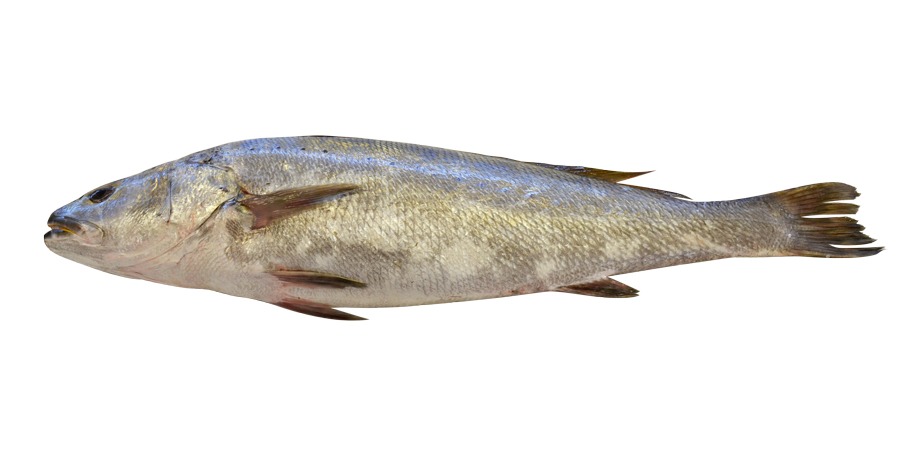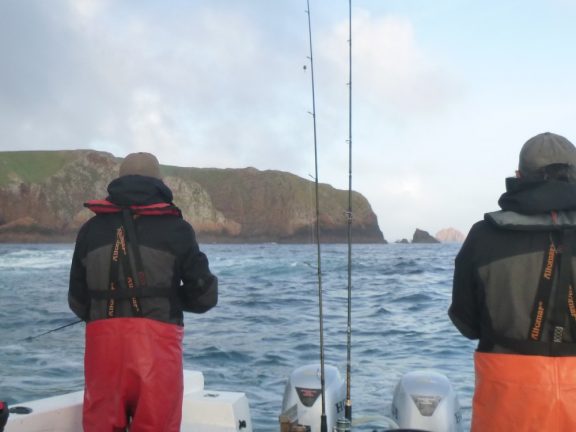These species are part of traditional Portuguese cuisine. With the Anzol+ project, we want to ensure quality fish by respecting environmental, economic and social sustainability criteria.
Throughout their area of distribution, these species are the target of commercial fishing, such as gillnets and trawling. Their continuity depends on a sustainable fishery using more selective fishing gear, like angling and longline, which keep the fish more intact, contributing directly to the valorisation of the species.
European Seabass
Dicentrarchus labrax

European Seabass
With its silver-grey, elongated body, the European Seabass is considered by many the king of our coast.
European Seabass mainly uses shallow waters (up to 100 m), and is very frequently observed along the Portuguese coast. It is a voracious predator, agile and fast, hunting small fish, crustaceans and invertebrates. Seabass are resistant to large temperature and salinity variations, and they breed from January to April.
All these characteristics make it a fish of excellence and its meat is used in a variety of dishes.
The fishing of this species requires passion and enthusiasm, as it is often a challenge to capture.
Minimum capture size
36cm
John Dory
Zeus faber

John Dory
John Dory has a dorsal fin with large spines which are reminiscent of a rooster’s crest, and a characteristic black spot. With a rounded and flattened body, this species is a solitary and more passive predator when compared to seabass, living at great depths (up to 400 m). It breeds in late winter and early spring.
This fish is much appreciated for the taste of its firm and delicate white meat.
Their fishing requires passion and great patience, as finding it is often a challenge.
Minimum capture size
No minimum size set.
Gilthead seabream
Sparus aurata

Gilthead seabream
With its silver-grey, oval body, the Gilthead seabream owes its name to the golden band on its head, between the eyes. The Gilthead seabream is undoubtedly the queen of the Sparidae family: its delicious meat is appreciated by all; an authentic delicacy. Born as a male, when it reaches 30cm in size it changes sex to spawn. It feeds mainly on bivalve molluscs, crustaceans and small fish. Their behaviour is sedentary and can be solitary or frequent small groups in seagrass prairies or sandy bottoms, as well as in surf areas.
Its capture is pleasurable and the species is known for pulling and headbutting while on the line.
Minimum capture size
19cm
White seabream
Diplodus sargus

White seabream
The white seabream is much appreciated in gastronomy. Oval and silvery with a characteristic black spot next to the caudal fin, this coastal species inhabits rocky areas and feeds mainly on molluscs, crustaceans, sea urchins and even seaweed. Like other sparids, it is very active and frequents the surf zone at dawn. Its varied diet makes it a highly sought-after species for consumption.
Its fishing is dangerous due to its location by the rocks, where fishing crews are at the sea’s mercy. But the difficulty adds to the adrenaline: the fight with these fish is addictive.
Minimum capture size
15 cm
European Conger
Conger conger

European Conger
It has a long, slender and cylindrical body. Its meat is white, very fine and extremely tasty, delighting any fish connoisseur. The conger inhabits the waters near the sandy or rocky sea bottom, living at great depths. It breeds only once in its lifetime, so its population does not recover easily. Their diet is based on crustaceans, fish and cephalopods, which they hunt at night. During the day it is mostly found in its lair.
It is fished mainly at night, using the art of bottom longline.
Minimum capture size
58cm
Meagre
Argyrosomus regius

Meagre
With an elongated body that can grow to a considerable size, the Meagre is another familiar species for most Portuguese consumers. Adults inhabit coastal waters and the continental shelf, near the bottom, midway or closer to the surface. They gather at the coast to spawn during spring and summer. Their diet consists primarily of fish and crustaceans. It is considered a “white fish” with firm meat, tasty and adaptable to a variety of recipes.
Their fishing is captivating due to their size and the struggle they put up. As soon as they feel the hook they tend to sink and do not get tired easily.
Minimum capture size
42cm



